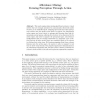Free Online Productivity Tools
i2Speak
i2Symbol
i2OCR
iTex2Img
iWeb2Print
iWeb2Shot
i2Type
iPdf2Split
iPdf2Merge
i2Bopomofo
i2Arabic
i2Style
i2Image
i2PDF
iLatex2Rtf
Sci2ools
103
Voted
ACCV
2010
Springer
2010
Springer
Affordance Mining: Forming Perception through Action
This work employs data mining algorithms to discover visual entities that are strongly associated to autonomously discovered modes of action, in an embodied agent. Mappings are learnt from these perceptual entities, onto the agents action space. In general, low dimensional action spaces are better suited to unsupervised learning than high dimensional percept spaces, allowing for structure to be discovered in the action space, and used to organise the perceptual space. Local feature configurations that are strongly associated to a particular `type' of action (and not all other action types) are considered likely to be relevant in eliciting that action type. By learning mappings from these relevant features onto the action space, the system is able to respond in real time to novel visual stimuli. The proposed approach is demonstrated on an autonomous navigation task, and the system is shown to identify the relevant visual entities to the task and to generate appropriate responses.
Related Content
| Added | 12 May 2011 |
| Updated | 12 May 2011 |
| Type | Journal |
| Year | 2010 |
| Where | ACCV |
| Authors | Liam Ellis, Michael Felsberg, Richard Bowden |
Comments (0)

